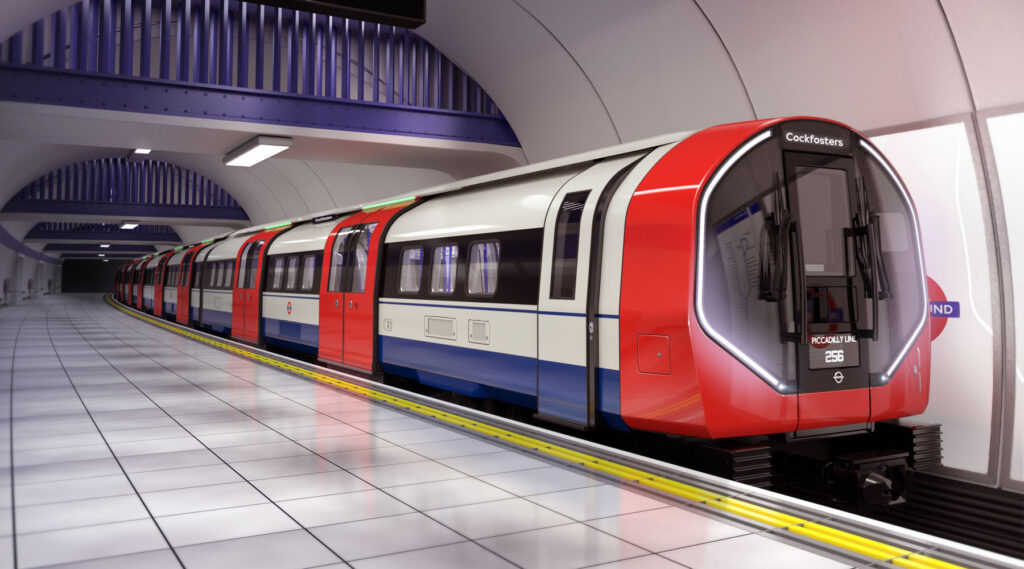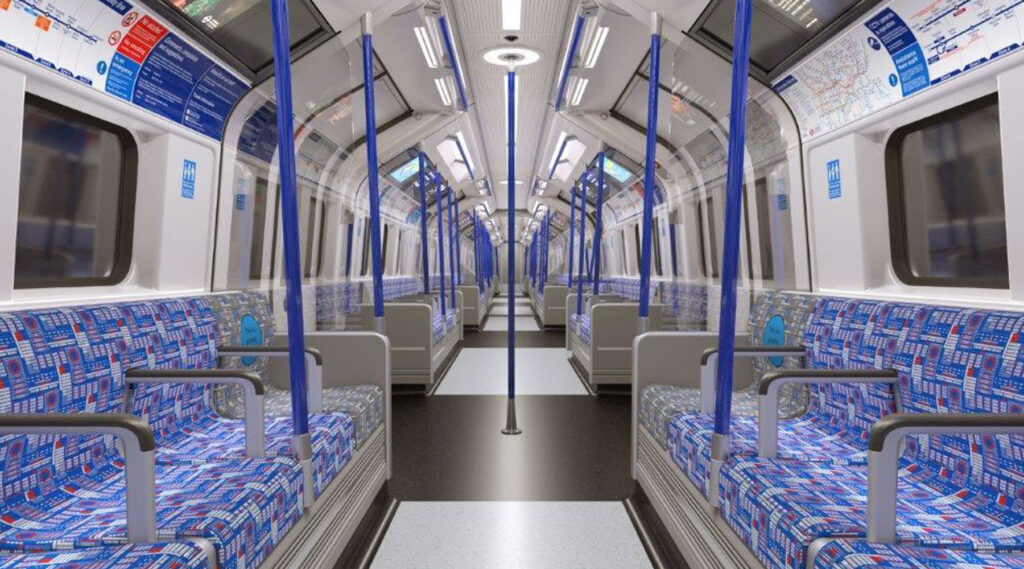The first of the new Piccadilly line trains that will start carrying passengers in 2025 has been spotted heading to a test track in Germany.
Most of the new trains are being built by Siemens at their new factory at Goole in Yorkshire, although the first units are being built at their factory in Vienna, Austria.
Before they can be used on the London Underground though, they need testing — and as it happens, Siemens owns an old British military base in Germany that’s been fitted with railways for testing trains.
That meant a number of photos being shared on social media of a London Underground train paying a visit to Germany via Sankt Pölten in Austria.
It's not every day that you see a tube train rolling through St. Pölten Hbf, Austria 😯 @geofftech (Photo taken by @S_Baeumchen) pic.twitter.com/d5O99Ek6GJ
— Jonas Gaiswinkler (@JGaiswinkler) July 19, 2023
New trains for the Piccadilly in Germany. These will be a huge upgrade for London when they’re introduced. Hopefully feeding into a wider line and signalling upgrade in the next 5-10 years (subject to funding) 🇩🇪 pic.twitter.com/sG40Ygjd1k
— Ed Dawes (@mindthedawes) July 19, 2023
The trains are heading to the former RAF Wildenrath, close to the border with the Netherlands, which was taken over by Siemens Mobility in 1997 as a large site for testing trains.
Most of the old RAF base is now covered in railway tracks, with a number of large loops and loads of sidings for running trains in numerous different scenarios. A dedicated track had to be built for the Piccadilly line trains though, which was completed earlier this year in readiness for the first train to arrive.
The train will then be put through a battery of tests to confirm it performs as expected so that it can pass technical acceptance tests. They don’t need to do that for every train they build, just the first few to ensure that the design is accepted for technical compliance.
Once the first couple of trains have passed technical acceptance testing, Siemens can ramp up production of the rest of the trains knowing that there won’t be any unexpected design changes to the fleet. The rest of the trains will also be tested before going into service to ensure they are fault-free, but that can be done on the Piccadilly line itself out of hours.
The new fleet of trains is needed as the current trains are over 45 years old, and the order to replace them was made in May 2018.
The first of the 94 new trains should enter passenger service in 2025.
The new trains will be fully walkthrough from end to end, will come with the world’s first deep-level tunnel air conditioning system, and live in-tunnel information screens about transport services. As the trains have much wider doors than the current trains, they can spend less time in stations picking up and dropping off passengers, TfL expects that to enable them to be able to increase peak capability on the Piccadilly line from 24 to 27 trains per hour from 2027.
Along with the 10 percent additional space inside the trains, the net effect is a capacity increase of around a quarter on the Piccadilly line compared to today.
There is also a — currently on hold — plan to upgrade the signalling system on the Piccadilly line, which would increase capacity from 27 to 36 trains per hour.
The new trains also have the theoretical ability to be upgraded at a later date to driverless operation, but that would at a minimum require a huge amount of upgrades to the stations first.









The ride height on the two photos you show from Germany seems way too high for a deep tube line. I’m wondering if they have been modified in some way to enable them to be hauled over the German main line.
They do look a bit off, don’t they? But the wheels do seem to be recessed up into the body a little, with the door areas hanging lower either side – so I wonder if that compensates.
I think you just don’t normally see the bottom half of tube trains as of the platforms
German platform heights are different?
There would be no point taking them to Germany if you had to modify them.As I understand it the main dimensions like the guage in Germany (and most of continental Europe) are the same as in UK.
Oh I do not like that additional blue stripe running immediately beneath the window, not one bit.
I wonder who will be the first to build a model railway of the former RAF Wildenrath test site….
Have the single doors at each end of each carriage been removed? I do not know if that is a good idea, even if the central pair double doors are wider, because Tube trains are restrictive in space, and moving down the carriage is tight.
Carriages are connected to each other same as the overground or Elisabeth line. You don’t have separate compartment, hence no sigle doors.
There are the equivalent of 17 double doors – 12 double doors and 10 single doors. The new trains have 18 sets of double doors – slightly more than today and they’re wider too.
I understand that the carriages are fully walkthrough, but a lot of the benefits of having a walkthrough will be missing comapared to the Elizabeth line/London Overground, because it is much harder and slower to walkthrough the train freely without bumping into people’s feets who are seated, due to the narrower and shorter trains (due to the loading gauge of deep level Tube tunnels), which is why the pair of single end doors in each carriage would have still been useful.
In the end, we’ll have to wait until the trains are in commercial service so that we can test it out in person.
The limiting factor of the Tube imo is the fact that the trains are still not wide at all. Even if doors get wider, people still need to get to them to be able to exit, and getting to them is still likely to be difficult.
I just wish that the tunnels could be widened to facilitate at least mainline sized British trains (not to mention proper high capacity Asian metro trains of minimum 3 metres wide), but doing so would probably be incredibly expensive to the point it would be better to construct new tunnels for new lines.
Have the single doors at each end of each carriage been removed? I do not know if that is a good idea, even if the central pair double doors are wider, because Tube trains are restrictive in space, and moving down the carriage is tight.
The new trains are fully walk-through, so the cramped vestibules at the end of the cars are a thing of the past.
This comment is a duplicate comment, because I accidentally commented the same content twice, but here’s a modified reply to the original:
It’s not just about the cramped ends. I understand that the carriages are fully walkthrough, but a lot of the benefits of having a walkthrough will be missing comapared to the Elizabeth line/London Overground, because it is much harder and slower to walkthrough the train freely without bumping into people’s feets who are seated, due to the narrower and shorter trains (due to the loading gauge of deep level Tube tunnels), which is why the pair of single end doors in each carriage would have still been useful.
The parts with seats are still cramped as well, so people at the end will still need to walk through seating areas to get to an exit.
In the end, we’ll have to wait until the trains are in commercial service so that we can test it out in person.
There are several videos, albeit in German, on YouTube about the test track. Just search on Wildenrath
Weird to see every other carriage being a different length
What’s weirder is the short cars look like they have no wheels? I’m not a rail engineer, but when I first read about the NTL I assumed they’d be Jacobs’ bogies between adjacent cars, but this looks like the odd cars have two wheelsets and the (shorter) even cars are somehow mounted between them.
*cries in Northern Line*
Those trains aren’t even 30 years old — they’ve got another 20 years of life in them yet.
Why are they always stingy with the number of seats.
Where would you put extra seats? They can’t install a top deck, like they can on buses. So the only way to have extra seats would be to have less doors, which would mean more time in stations, and therefore a lower train frequency — which in turn probably means even *less* seats per hour.
So there is plenty of standing room
Presumably the gauge is the same as European, including British rails.Those trains should make their journey here not by low loaders on the road but as a ‘goids’ train using rail from start, through channel tunnel to final destination
My brain is struggling with the floating carriages that have no bogies at all. How the hell does that even work? haha
Why oh why was blue introduced for Tube trains? They were always red or white or silver in my lifetime.
reminds me too much of National rail…
Reminiscent of the mock up shown at the ex-Siemens Crystal place in Docklands a decade ago… Comments are saying some cars are unequal length, as the photos suggest, but that’s not mentioned in the piece. Nor is the fact that this will surely be the first walkthrough deep-level train set. There will be plenty of ability to actually walk through – even in (c)rush hour, leaving aside the fact tube usage is still significantly down.
How does the order for this or that line trains is done? Are the trains interchangeable with at least some of other London Underground lines or is each line unique and is being supplied with trains independently?
Broadly speaking – when you open a new line, you’ll need to buy a whole new fleet of trains to run on it. That whole fleet will age at the same speed and need replacing all at once. So yes, it will be done line by line.
The Wildennrath site was originally a prototype test construction for the Autobahn